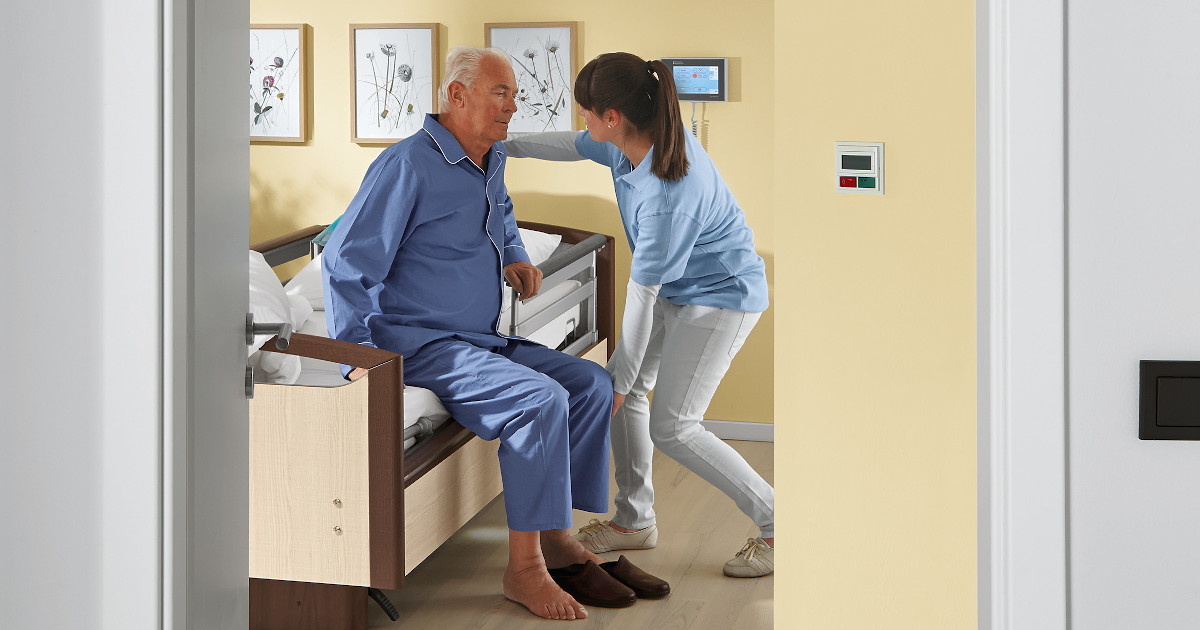Mobility is quality of life. But with age, mobility is lost. Seniors can no longer lift daily routines, such as getting up or getting dressed, or no longer trust themselves to do so. It doesn’t have to come to that: Below are tips on how caregivers can maintain and promote resident mobility.
Mobilization: activating measures for the whole body
Sitting up in bed after waking up or putting on a fresh shirt: for healthy people, these are often unconscious processes. For seniors, these actions integrated into everyday life can be challenging. With mobilization, caregivers can help residents be more independent with a higher quality of life.
Activating actions can be integrated into daily routines. Mobilization often takes the form of movement in or around the bed with the goal of promoting self-motion. For example, a new position in bed can be challenging and trained for highly immobile seniors. Or even getting out of bed with a few steps to a supportive walker. If the exercises are adapted to the resident’s degree of mobility, movements of individual body parts can be trained in a targeted manner. This also improves the general state of health.
Contracture prophylaxis: Keeping joints mobile
Bed confinement or too little movement causes muscles to shorten and joint capsules to change. The result: joints stiffen, freedom of movement is lost. But these often irreversible contractures can be prevented. What can this look like in everyday nursing care? Seniors need a flexible wrist for the rotating motion of brushing their teeth or combing their hair. Caregivers can motivate residents to repeat these movements on their own and more often during the day than necessary – with the help of the specialist, of course.
Fall prevention and environmental adaptation: providing safety
Falls often result in bed confinement, or seniors become unsteady in their mobility as they age. To prevent this, they can practice walking safely with or without a walker through exercises that promote balance and strengthen muscles. Caregivers should also practice with them using grab bars and walkers.
Fall prevention also means avoiding hazards in a resident’s environment. Caregivers must point out tripping hazards, such as carpet edges or cables, and ideally eliminate them with the senior. The expert standard „Preservation and Promotion of Mobility 2020“ refers to this as a mobility-promoting environment. In other words, a kind of „safe space,“ an environment in which residents feel secure in their mobility and protected from danger.
Mobility-promoting leisure activities: Fun to move around
While mobility promotion means physical activation, it has a social component. After all, immobility can lead to isolation, as those affected are often physically unable to participate in the community. What better way, therefore, than to activate the body together? Group offers seem to be the optimal mix between social interaction, targeted exercises and fun. In addition to exercises that strengthen muscles, caregivers can provide offerings, such as yoga or Greek dance, for the fun factor.
The expert standard „Maintenance and Promotion of Mobility“ sees it as the task of nursing staff to provide residents with offers that stimulate their own movement. A good incentive is group activities that are fun and where residents can motivate each other.
Communication and motivation: promoting self-esteem
People who are physically active live independently and autonomously. This has an impact on quality of life and mental strength. Caregivers should talk clearly with residents about the purpose of mobility-enhancing exercises and at the same time encourage them to be active. Even after a short time, successes can be seen that increase self-esteem. Then it’s a matter of „staying on the ball!“ Especially after minor setbacks, professionals should be able to point out what the seniors have accomplished since starting the exercises and what successes are still pending with further exercise.


